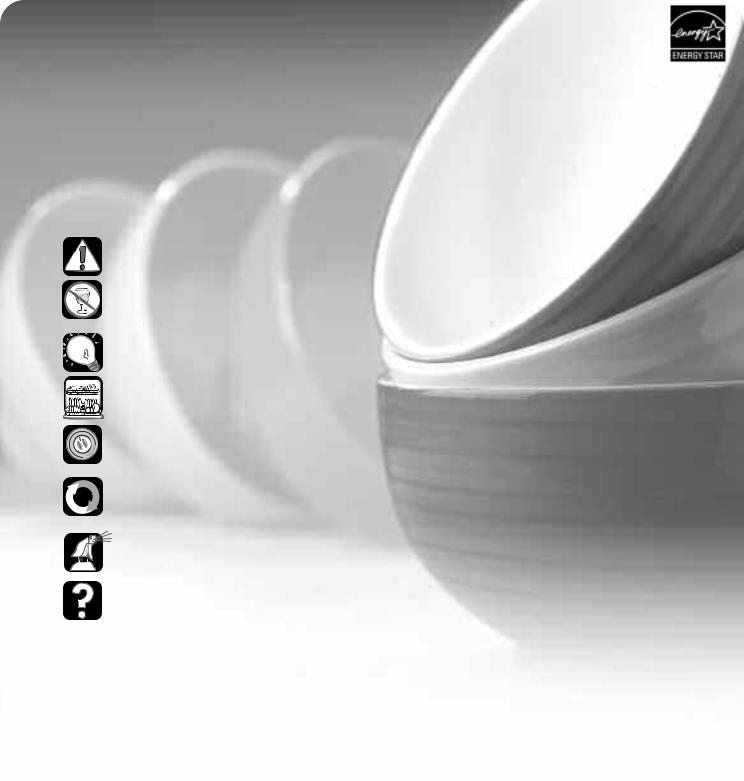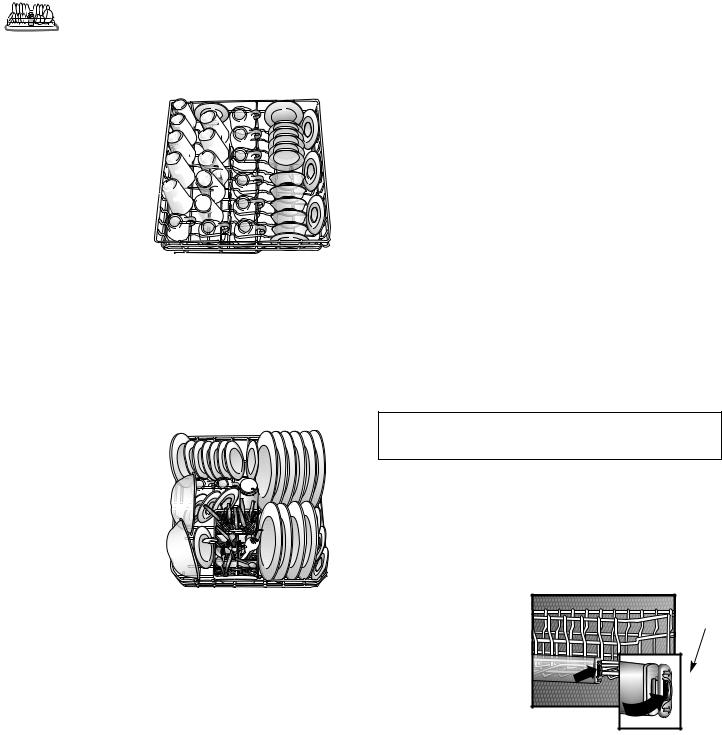Jenn-Air JDB3610BWE, JDB3610BWX, MDB4601AWE, MDB4601AWX, PDBL290AWE Owner's Manual
...
TOUCH
Dishwasher
Use & Care Guide
Table of Contents
Safety . . . . . . . . . . . . . . . . . . . . . 1
What Can and
Cannot be Washed . . . . . . . . . . .2
Operating Tips . . . . . . . . . . . . . . 3
Loading . . . . . . . . . . . . . . . . . . . 4
Dishwasher Use . . . . . . . . . . . . 5
Cycles, Options
and Lights . . . . . . . . . . . . . . . 6-7
Care and Cleaning . . . . . . . . 7-8
Troubleshooting . . . . . . . . . 9-10
Guide d’utilisation
et d’entretien . . . . . . . . . . . . . .12
Guiá de Uso y Cuidado . . . . . 24
Part No. 6 919680 B |
©2005 Maytag Appliances Sales Co. |

Installer: Please leave this guide with this appliance.
Consumer: Please read and keep this guide for future reference. Keep sales receipt and/or cancelled check as proof of purchase.
Model Number __________________________________
Serial Number ___________________________________
Date of Purchase _________________________________
If you have questions, call:
1-800-688-9900 USA and 1-800-688-2002 CANADA 1-800-688-2080 (U.S. TTY for hearing or speech impaired) (Mon.-Fri., 8 am-8 pm Eastern Time)
In our continuing effort to improve the quality and performance of our appliances, it may be necessary to make changes to the appliance without revising this guide.
 Safety
Safety
What You Need to Know About Safety Instructions
Warning and Important Safety Instructions appearing in this guide are not meant to cover all possible conditions and situations that may occur. Common sense, caution and care must be exercised when installing, maintaining or operating the dishwasher.
Always contact your manufacturer about problems or conditions you do not understand.
Recognize Safety Symbols, Words, Labels
 WARNING
WARNING
WARNING – Hazards or unsafe practices which COULD result in severe personal injury or death.
 CAUTION
CAUTION
CAUTION – Hazards or unsafe practices which COULD result in minor personal injury or property damage.
Important Safety Instructions
 WARNING
WARNING
Check with the installer to make sure the appliance has been properly grounded to avoid possible electrical shock. Be sure you read the important personal safety instructions before you use this dishwasher.
Products with a  label have been listed with Underwriter’s Laboratories, Inc. – those with a CSA tag have been listed with Canadian Standards Association. Nevertheless, as with any other equipment using electricity and moving parts, there is a potential hazard.
label have been listed with Underwriter’s Laboratories, Inc. – those with a CSA tag have been listed with Canadian Standards Association. Nevertheless, as with any other equipment using electricity and moving parts, there is a potential hazard.
 WARNING
WARNING
When using your dishwasher, follow basic precautions including the following:
1.Read all instructions before using the dishwasher.
2.Use the dishwasher only for its intended function.
3.Disconnect electrical power to dishwasher before attempting to service.
4.To avoid electrical shock hazard, the sides and back must be enclosed and the front panels must be attached before electrical power is applied to the dishwasher. Refer to the installation instructions for proper grounding procedures.
5.Connect to a properly rated, protected and sized power supply circuit to avoid electrical overload.
6.Children should never be permitted to operate, or play in, with, or around this dishwasher.
7.To reduce the risk of injury when loading items to be washed, sharp or pointed items should be located with the handles up. Also, load sharp items so they are not likely to damage the door seal.
8.Do not touch the heating element on the bottom of the tub during or at the completion of a cycle. It will be hot.
9.Use only detergents and rinse additives designed for a residential automatic dishwasher. Never use soap, laundry detergent, or hand washing detergent in your dishwasher. Keep these products out of reach of children.
10.Do not sit, stand on or abuse the door or dish racks of the dishwasher.
11.Under certain conditions, hydrogen gas may be produced in a hot water system that has not been used for two weeks or more. Hydrogen gas is explosive. If the hot water system has not been used for such a period, turn on all hot water faucets and let the water flow from each for several minutes. This will release any accumulated hydrogen gas. As the gas is flammable, do not smoke or use an open flame during this process.
12.Do not wash plastic items unless marked “dishwasher safe” or the equivalent. For plastic items not so marked, check the manufacturer’s recommendations.
13.Do not tamper with controls.
14.To prevent accidental child entrapment and suffocation risks, always remove the door to the washing compartment when removing an old dishwasher from service or discarding it.
15.Use caution when unloading the dishwasher. Dishes will be hot if unloaded shortly after a cycle has completed.
16.Certified residential dishwashers are not intended for licensed food establishments.
17.To avoid water, mold or mildew damage to your home, inlet and drain hose connections should be
checked periodically for leaks.
|
Save These Instructions |
1 |
for Future Reference |

 What Can and Cannot Be Washed
What Can and Cannot Be Washed
Most tableware, cookware and flatware can safely be washed in your dishwasher. Check with the manufacturer.
MATERIAL |
DISHWASHER SAFE? |
SPECIAL INFORMATION |
|
Aluminum |
Yes, except anodized. |
High water temperature and detergents may affect finish. |
|
|
|
|
|
Cast Iron |
No |
Seasoning will be removed, and iron will rust. |
|
|
|
|
|
China/Stoneware |
Yes, except antique or |
Always check manufacturer’s recommendation before washing. |
|
|
hand-painted. |
Antique, hand-painted or over-the-glaze patterns may fade. Gold |
|
|
|
leaf may discolor. |
|
|
|
|
|
Crystal |
Yes, except antique or |
Always check manufacturer’s recommendation before washing. |
|
|
delicate crystal. |
Some types of leaded crystal may etch with repeated washings. |
|
|
|
|
|
Filters |
Not recommended. |
May leave a dingy deposit or stain on dishwasher interior. |
|
|
|
|
|
Glass |
Yes |
A specialty glass called milk glass can yellow with repeated |
|
|
|
dishwasher washing. |
|
|
|
|
|
Gold-Plated |
No |
Will discolor. |
|
Flatware |
|||
|
|
||
|
|
|
|
Pewter, Tin |
No |
|
|
|
|
|
|
Plastics |
Yes, top rack, except |
Always check manufacturer’s recommendation before washing. |
|
|
disposable plastic |
Plastics vary in their capacity to withstand high water |
|
|
items. |
temperatures and detergents. Disposable plastic items are not |
|
|
|
dishwasher safe for this reason. |
|
|
|
|
|
Stainless Steel |
Yes |
Run a Rinse Only cycle if not washing immediately. Prolonged |
|
|
|
contact with foods containing salt, vinegar, milk products or juice |
|
|
|
could damage finish. |
|
|
|
|
|
Sterling Silver or |
No, if has commercial |
Always check manufacturer’s recommendation before washing. |
|
Silverplate |
“darkening”. |
Run a Rinse Only cycle if not washing immediately. Prolonged |
|
|
|
contact with food containing salt, acid or sulfide (eggs, |
|
|
|
mayonnaise and seafood) could damage finish. Commercial |
|
|
|
“darkening” may be removed by detergent. |
|
|
|
|
|
Wooden Items |
No |
Wood may warp, crack or discolor. |
|
|
|
|
2




 Operating Tips
Operating Tips
Before You Start
•Don’t prerinse. Simply scrape off any bones or large food particles.
•If connected to a food waste disposer, make certain the disposer is empty before starting the dishwasher.
•Scrape off tomato-based food soils (see page 7).
•Remove certain foods such as mustard, mayonnaise, lemon juice, vinegar, salt or dressings from stainless steel flatware as soon as possible.
These foods may cause rusting and pitting if allowed to remain in contact with the surface for an extended period of time.
Starting the Dishwasher
1.After loading the dishwasher and adding detergent, close the dishwasher by pressing the door until the latch clicks.
2.To start the dishwasher, firmly press the desired cycle and options pads. After a pause, the fill will begin. To prevent an unplanned cycle or option change, these selections are “locked in” after 1 minute.
3.The indicator lights for the selected cycle and options will glow.
4.To cancel an option, press the pad again.
5.To cancel a cycle, press the Drain/Off pad.
6.Pressing the Drain/Off pad once will drain the dishwasher and then turn it off. Pressing the pad twice will turn it off without draining.
Adding a Forgotten Item
For best cleaning, the forgotten item should be added early in the cycle.
1.Press the Delay/Resume pad or unlatch the door.
2.Wait for the water circulation to stop.
3.Open the door and add the item.
4.Close and latch the door.
5.If Delay/Resume was pressed, press it again to restart the dishwasher.
6.After five seconds, the cycle resumes automatically at the point of interruption.
General Recommendations
(Rack features vary by model)
•Place all items in the racks so they are separated and facing the center of the racks.
•Wedge flat, lightweight items next to the silverware basket or along the sides and back of the racks.
•Load items so they do not rest over the wash tower located in the center of the lower rack.
•Avoid blocking the upper and lower spray arms by not allowing items to extend beyond the racks.
•Place glasses in any row of the upper rack for proper cleaning and rinsing. Do not load glasses over the tines.
3

 Loading
Loading
Upper Rack
This rack is designed
to hold glasses, cups, small plates, bowls, cookware, etc. Small plates, bowls or saucers
should be |
|
|
loaded with soiled |
|
|
surfaces facing the |
|
|
center of the rack. |
|
|
Do not load |
|
|
glasses over the |
10 Place Settings |
|
tines. |
||
|
The Twin Shelf (select models) on the right side of the upper rack folds up or down. Fold it down to hold longhandled knives, spatulas and spoons or short items like cups or juice glasses. Fold it up for taller items like bowls, plates, etc.
Lower Rack
Large items may be placed in any convenient location in this rack. Keep soiled
surfaces facing the center of the rack. The back of this rack accommodates a row of dinner plates or two rows of smaller plates.
Serving bowls, pots
and pans also fit across the left side of the rack.
Folding tines (select models) located on the right side, provide loading flexibility for large-shaped items.
Utensil Basket
Removable Utensil Basket with Handle (style may vary)
For best cleaning results, prevent items from nesting together by placing some items in the basket with handles up and some with handles down. Load knives, handles up, through the slots in the covered section (when closed).
Be sure that thin, finely pointed items do not extend through the basket. This could block the lower wash arm.
Small, lightweight items like baby spoons and plastic measuring spoons should be placed in the covered section (select models) of the basket for washing.
Removing the Upper Rack
The upper rack can be removed when tall or oversized items need to be loaded into the lower rack.
Note: Avoid resting items over the center wash tower.
To remove:
1.Roll the upper rack 1/3 to 1/2 of the way out.
2.Remove the plastic rack stop from the end of each track. To remove each plastic rack stop, push inward (towards the rack) on the ridged area of the rack stop. The rack stop
will snap open and can be easily removed by pulling straight out. Take care to support the track while removing rack stops.
3.Roll the rack all the way out of the track
and remove from the dishwasher.
4.Reverse the above procedure to replace the upper rack into the dishwasher.
4

 Dishwasher Use
Dishwasher Use
Hot Water
For optimal cleaning and drying results, hot water is necessary. The incoming water temperature should be 120° F (49° C) to properly activate the detergent and melt greasy food soils.
To check the incoming water temperature, turn on the hot water faucet nearest the dishwasher and let it run into a glass in the sink. Place a candy thermometer in the glass and check the temperature once it has stopped rising.
Detergent
Use a detergent designed specifically for use in an automatic dishwasher. Be sure it is fresh. Store granular detergent in a cool, dry place (not under the sink).
Recommended Amount
Too little detergent results in poor cleaning, hard water filming/spotting and poor drying. Too much detergent can cause permanent etching/cloudiness.
Suds can cause the dishwasher to overflow. Measure the detergent carefully and use only detergents designed for use in a dishwasher. Less detergent is needed in soft water. Try another brand of detergent if sudsing continues.
The amount of detergent to use is determined by the hardness of the water and soil level of the load. Refer to the following chart for detergent usage recommendations.
WATER |
SOIL |
DETERGENT AMOUNT |
|
HARDNESS* |
LEVEL |
(PER CUP DOSAGE) |
|
|
|
|
|
Soft |
Light Soil |
5 |
teaspoons |
(0-4 gpg) |
Normal Soil |
6 |
teaspoons |
|
Heavy Soil |
8 |
teaspoons |
|
|
|
|
Medium |
Light Soil |
7 |
teaspoons |
(5-9 gpg) |
Normal Soil |
8 |
teaspoons |
|
Heavy Soil |
10 teaspoons |
|
|
|
|
|
Hard |
Light Soil |
9 teaspoons |
|
(10-12 gpg) |
Normal Soil |
10 teaspoons |
|
|
Heavy Soil |
12 teaspoons |
|
|
|
|
|
*Your local water utility or state university extension service can tell you the degree of water hardness in your area.
In extremely hard water conditions (13 grains per gallon or more*), it is difficult to achieve good results with any dishwasher. A mechanical water softener may be necessary to improve water quality, detergent effectiveness, and protect the dishwasher parts from the damage that hard water can cause.
Add recommended amount of detergent to each cup as shown and close the detergent lid.
Do not use detergent with the Rinse Only (select models) cycle. Leave the detergent lid open when running Rinse Only (select models).
Rinse Aid
A liquid rinse aid dispenser (select models) automatically releases a measured amount of rinse aid into the final rinse portion of each cycle.
To fill the dispenser, turn the cap counterclockwise to open. Pour the rinse aid into the reservoir. Replace the cap and be sure it is securely in place before closing the dishwasher door. Check the dispenser monthly and refill as needed.
Rinse aid is available in solid form for models without a liquid dispenser. When using a solid rinse aid, fasten it to the back right corner of the lower rack. Purchase more rinse aid when the material dissolves and the container is empty.
5

 Cycles, Options and Lights
Cycles, Options and Lights
Cycles
Choose the cycle that best describes your dishload by pressing the cycle select pad. (See page 3, Operating Tips, for how to begin the cycle).
CYCLE |
DESCRIPTION |
SEQUENCE |
WATER USE |
|
|
|
|
Pots & Pans or |
Long cycle for heavily soiled dishes, pots and pans. |
2 Prewashes, |
|
Scour Wash |
|
Main Wash, Purge, |
10 gallons |
(select models) |
|
2 Rinses |
|
Heavy Wash |
Medium cycle for average food soils. |
2 Prewashes, |
8 gallons |
|
|
Main Wash, Purge, |
|
|
|
Rinse |
|
Normal Wash |
Short cycle for light food soils. |
Wash, Purge |
6 gallons |
|
|
2 Rinses |
|
Rinse Only |
Rinses dishes being held until there is a full load. |
Rinse, Off |
2 gallons |
|
|
|
|
Note: Depending on water temperature, there may be time added to the cycle to bring water up to temperature.
Options
In addition to choosing a cycle, choose as many available options as are needed for your dishload.
OPTION |
DESCRIPTION |
USE WITH CYCLES |
|
|
|
Delay/Resume |
Delay/Resume can delay or interrupt any wash cycle for 2, 4, or 6 hours. To |
All Cycles |
|
set up a delay, first select the appropriate cycle and options for the load. |
|
|
Then, quickly press and hold the Delay/Resume pad until the desired |
|
|
amount of delay time is selected. The dishwasher will count down and the |
|
|
cycle will automatically start as soon as the delay time expires. If you wish |
|
|
to cancel the delay start, simply press the Delay/Resume pad again. The |
|
|
indicator light will go out and the cycle will start immediately. This pad can |
|
|
also be pressed to temporarily interrupt a cycle. The cycle will resume from |
|
|
the point of interruption when the delay time runs out or when the |
|
|
Delay/Resume pad is pressed again. |
|
Hi Temp or |
Hi Temp/Temp Boost checks the main wash and final rinse water |
All Cycles |
Temp Boost |
temperatures and will extend the heating and water circulation until proper |
(except Rinse Only) |
(select models) |
water temperature is reached. Select Hi Temp/Temp Boost to ensure |
|
|
proper water temperature for activating detergent and dissolving greasy |
|
|
food soils. |
|
|
|
|
Heated Dry |
Heated Dry turns on the heating element during dry for enhanced drying |
All Cycles |
|
results. Cancelling Heated Dry turns the heating element off. Towel drying |
(except Rinse Only) |
|
of some items may be necessary. In models with plastic interiors, it is |
|
|
normal to notice vapor escaping from the door vents as the heat dries your |
|
|
dishes. Vapor will escape even if Heated Dry is not selected. |
|
Drain/Off |
Pressing the pad once will drain the dishwasher and then turn it off. |
|
Pressing the pad twice will turn it off without draining. |
|
|
|
|
|
|
|
|
 CAUTION
CAUTION
CAUTION – In models with plastic interiors, it is normal to notice vapor escaping from the door vent in the upper left corner of the door as the heat dries your dishes. The vapor is hot and may cause minor burns.
6

 Cycles, Options and Lights
Cycles, Options and Lights
Lights/Display (select models)
INDICATOR |
DESCRIPTION |
|
|
Clean |
Illuminates at the end of the dry cycle. |
|
|
Dry |
Illuminates during the entire dry period and goes out when the cycle is completed. |
|
|
Wash |
Illuminates during all wash portions of the cycles. |
|
|
Heating Delay |
Illuminates when cycle is being extended to heat the water. |
|
|
 Care and Cleaning
Care and Cleaning
General Recommendations
•The dishwasher interior is normally self-cleaning. Periodically check the bottom of the dishwasher tub to see if any large particles remain.
•Wipe the edge of the inner door liner to remove any food soil splashes which occurred during loading.
•When cleaning stainless steel, always wipe with the grain. Never use products containing chlorine bleach or citric acid.
•The color from some tomato-based food soils may occasionally adhere to various components of the dishwasher interior, causing temporary discoloration.
To minimize this:
•Remove excess tomato-based food soils from dishes, before loading.
•Run the Pots & Pans or Scour Wash (select models) cycle when washing loads containing tomato-based food soils.
•Use a dishwasher detergent that contains chlorine to better fight staining.
LOCATION |
SOIL LEVEL |
TREATMENT |
|
|
|
Standard Exterior |
Light to moderate |
Soft damp cloth and liquid spray cleaner. |
|
|
Do Not use abrasive powders or cleaning pads. |
Stainless Steel Exterior |
Daily cleaning and light soil |
Soft cloth or sponge and one of the following: |
(select models) |
|
• Mild detergent and water |
|
|
• A solution of white vinegar and water |
|
|
• Formula 409 Glass and Surface Cleaner*, or |
|
|
similar multi-surface cleaner. |
|
|
• Do Not use products containing chlorine bleach |
|
|
or citric acid. |
|
|
Follow with rinse and dry. |
|
Moderate to heavy soil |
Soft cloth or damp sponge and Bon Ami*. Follow |
|
|
with rinse and dry. |
|
Streaks or fingerprints/restore shine |
Soft cloth and Stainless Steel Magic Spray**. |
|
Discoloration |
Soft cloth or damp sponge and Cameo Stainless |
|
|
Steel Cleaner*. Rinse immediately and dry. |
Interior |
Light to moderate |
Soft cloth or damp sponge. |
|
Discoloration, or tomato-based stain |
Switch dishwasher detergent to chlorine-based |
|
|
product. |
|
|
|
*Brand names are trademarks of the respective manufacturer. **Call 1-877-232-6771 to order.
7

 Care and Cleaning
Care and Cleaning
 WARNING
WARNING
Electrical Grounding Instructions - Portable models are equipped with a (three-prong) grounding plug for your protection against shock hazard and should be plugged directly into a properly grounded receptacle. Do not cut or remove the grounding prong from this plug.
Connecting a Portable
Dishwasher
1.Turn on the faucet at the sink until the water runs hot. Turn off the faucet.
2.Pull the connector from the recess in the back of the dishwasher.
3.Press down on the thumb release and lift the connector onto the faucet.
4.Remove pressure from the thumb release and tug slightly on the connector to be sure it is securely in place.
5.Turn the hot water on full force.
6.Check that the sink drain is open so water from the dishwasher can drain properly.
7.Pull the electrical cord from the recess. Plug it into a properly grounded outlet.
8.Select the proper cycle and options for the load and start the dishwasher.
Storage/Moving
Fill both detergent cups with a fresh-scented dishwasher detergent or baking soda and select the Heavy Wash cycle. Allow the dishwasher to complete the cycle. Then turn the water supply off and drain the dishwasher. To drain, press the Drain/Off pad once to activate the drain. Operate the drain twice to ensure most of the water is removed. Last, disconnect the electrical supply and prop open the door.
When turning the water supply to the home off, the water shut off at the dishwasher must be turned off also.
Disconnecting A Portable
Dishwasher
1.Be sure to turn the water supply off and press the pressure release button BEFORE removing the connector.
2.Press down on the thumb release and remove the connector from the faucet.
3.Push the connector and hoses back into the cabinet recess.
4.Unplug the electrical cord and push it back into the cabinet recess.
To Change the Door Panel
Insert (select models)
 WARNING
WARNING
WARNING – Disconnect electrical power to the dishwasher before changing the door panel insert.
1.Using a Phillips screwdriver, remove either the right or left-hand door trim strips by removing the three screws.
2.Grasp the panel insert(s) and gently flex out slightly. Slide panel(s) out about two inches. Continue to flex insert panel(s) enough to remove them. Use care, edges may be sharp.
3.Select color and reinstall panel(s). Place insert panel(s) (notched corners at the top) on the inside of the lower door panel trim. Make sure the upper notched corners of the insert(s) are under the control panel.
4.Reinstall the side trim.
8

Troubleshooting• |
|
CHECK THESE POINTS TO HELP SAVE YOU TIME AND MONEY. |
|
PROBLEM |
SOLUTION |
Dishwasher will not fill |
• Be sure door is latched securely. |
|
• Be sure the water is turned on. |
|
• Check that the pad is properly selected for a cycle. |
|
• Allow time for select models to drain/pause before filling. |
|
Check your home’s circuit breaker or fuse box. |
|
• Check inlet hose for a kink. |
|
• Check water valve inlet for sediment and clean if necessary. |
|
|
Dishwasher will not drain/ |
• If hooked up to a food waste disposer, be sure the knock-out is removed from the |
water in tub bottom |
disposer inlet. |
|
• Be sure the drain hose is elevated at least 32” so water cannot siphon back into the |
|
tub. |
|
• Check for food obstruction in the drain or disposer. |
|
• Check drain hose for a kink. |
|
• Check your home’s circuit breaker or fuse box. |
|
• Check that the cycle is completed. |
|
|
Detergent cup is not empty |
• Check that the cycle is completed. |
|
• Be sure dispenser is not blocked. |
|
• Use fresh detergent stored in a cool, dry place. |
|
|
Dishwasher seems noisy |
• A water valve hiss during fill is normal. |
|
• Water circulation sounds are normal. |
|
• A ticking noise is a normal timer sound. |
|
• A thumping sound may be a wash arm bumping an item that is extending beyond the |
|
racks. Readjust load to avoid obstructing wash arm. |
|
• Chopping or grinding sounds may be heard as the internal chopper blade chops hard |
|
items like fruit seeds, nuts, etc. |
|
• Humming during the drain is normal. |
|
• A snap noise is the detergent cup lid hitting the door liner when the dishwasher door |
|
is opened at the end of the cycle. This is normal. |
|
• Proper installation affects the noise level. |
|
|
Cycle takes too long |
• Hi Temp or Temp Boost (select models) has been selected and the cycle is extended |
|
to heat water. |
|
• Check to see that the incoming water temperature is 120° F (49° C). |
|
|
Dishwasher has an odor |
• Run dishes being held in the dishwasher through a Rinse Only cycle (select models). |
|
• Many dishwashers have a “new” smell when first installed. This will dissipate with use. |
|
• Dishwasher may not be draining properly. (See “Dishwasher Will Not Drain” section.) |
|
• For a strong odor, place baking soda in both sides of the detergent cup. Select |
|
Normal Wash cycle and allow the water to circulate for about 10 minutes. Interrupt |
|
the cycle by unlatching the door and let it stand overnight. Restart the dishwasher by |
|
latching the door and allow it to complete the cycle. Another alternative is to use a |
|
dishwasher cleaning product such as Jet-Dry Dishwasher Cleaner*. |
|
|
Dishwasher leaks |
• Check that the dishwasher is level. (Refer to the Installation Instructions.) |
|
• Suds can cause the dishwasher to overflow. Measure the detergent carefully and use |
|
only detergents designed for use in a dishwasher. Less detergent is needed in soft |
|
water. Try another brand of detergent if sudsing continues. |
|
• Follow directions closely on how to add a forgotten item (pg. 3). |
|
• To avoid rinse aid leaking from the dispenser (select models), be sure the lid is |
|
securely attached. |
*Brand names are trademarks of the respective manufacturer. |
Cont. |
|
9 |

|
Troubleshooting• |
|
|
|
|
|
|||
|
PROBLEM |
SOULTION |
|
|
|
Food soil remains |
• Check water temperature. Incoming water should be 120° F (49° C). |
|
|
|
on dishes |
• Run hot water at the sink before starting the dishwasher. |
|
|
|
|
• Select Hi Temp or Temp Boost (select models). |
|
|
|
|
• Check water hardness and adjust detergent amount accordingly (pg. 5). |
|
|
|
|
• Use fresh detergent stored in a cool dry place. |
|
|
|
|
Select proper cycle for the soil level (pg. 6). |
|
|
|
|
• Load items so they do not block the wash arms or center tower (pg. 4). |
|
|
|
|
• Load the utensil basket with knife handles up and spoon and fork handles down. |
|
|
|
|
• Do not place glasses over tines. |
|
|
|
|
• Before loading, scrape off burnt on foods and wipe the starchy film from utensils used with |
|
|
|
|
pasta, rice and oatmeal. These soils require more energy than the rest of the load to clean. |
|
|
|
Glasses are cloudy/ |
• Select Hi Temp or Temp Boost (select models). |
|
|
|
spotted |
• Check water temperature. Incoming water should be 120° F (49° C). |
|
|
|
|
• Always use a rinse aid. |
|
|
|
|
• Confirm that the cloudiness is removable by soaking the item in white vinegar for |
|
|
|
|
approximately 5 minutes. If removed, the problem is due to hard water. Adjust detergent |
|
|
|
|
amount being used to match water hardness (pg. 5). Be sure detergent is fresh, stored |
|
|
|
|
properly and is a high quality brand. |
|
|
|
|
• If cloudiness is not removable, it is etching. This is an erosion of the surface of the |
|
|
|
|
glassware and can be caused by water that is too hot, from using too much detergent or |
|
|
|
|
by prewashing. Detergent needs food soil to act upon. If etching has occurred, the |
|
|
|
|
glassware is permanently damaged. To prevent further etching, adjust the detergent |
|
|
|
|
amount to match the water hardness, stop prewashing, and use water heating options only |
|
|
|
|
when incoming water temperature is below 120° F (49° C). |
|
|
|
Items washed in the |
• Aluminum utensils or pans can leave marks when they rub against other items. Leave a |
|
|
|
dishwasher or the |
slight space between items. |
|
|
|
dishwasher tub itself |
• Iron deposits in the water can leave a yellow, brown or orange film on dishes or the |
|
|
|
are stained/ discolored |
dishwasher tub. A rust filter may be needed. Check with a water treatment company. |
|
|
|
|
• Separate silver or silver-plated silverware from stainless steel. These metals can be |
|
|
|
|
damaged by contact with each other during washing. |
|
|
|
|
• Color from tomato sauces may adhere to the interior parts of the dishwasher (pg. 7). If |
|
|
|
|
light staining has occurred, leave the door open to oxidize the stain away. Use a |
|
|
|
|
dishwasher detergent that contains chlorine to better fight staining. |
|
|
|
|
• Certain dishwasher detergents may stain silver. Try another brand of detergent. |
|
|
|
|
|
|
|
|
Items not properly |
• Be sure Heated Dry is selected. |
|
|
|
dried/moisture is |
• Water droplets may form on the inner door as part of the drying process. |
|
|
|
present on the |
• Use a rinse aid separate from the detergent like Jet Dry* or Cascade Rinse Aid* regularly, |
|
|
|
dishwasher interior |
to improve drying. Turn the rinse aid selector toward the MAX setting (select models). |
|
|
|
after the dry cycle |
• Check water temperature. Incoming water should be 120° F (49° C). |
|
|
|
|
• Select Hi Temp or Temp Boost (select models). |
|
|
|
|
• Increase detergent amount to match water hardness (pg. 5). |
|
|
|
|
• Load properly. (pg. 4) |
|
|
|
|
• Plastic and items with non-stick surfaces are difficult to dry because they have a porous |
|
|
|
|
surface which tends to collect water droplets. Towel drying may be necessary. |
|
|
|
|
• Glasses and cups with concave bottoms hold water and require towel drying. Locate these |
|
|
|
|
items on the more slanted side of the rack for improved results. |
|
|
|
|
|
|
|
|
Dishware is chipped |
• Load dishes according to instructions so they do not strike each other (pg. 4). |
|
|
|
|
• Washing fine antique china/crystal in the dishwasher is not recommended. |
|
|
|
|
• Do not load glasses over the tines. |
|
|
|
|
• Do not overload. |
|
|
|
|
|
|
|
*Brand names are trademarks of the respective manufacturer.
10
